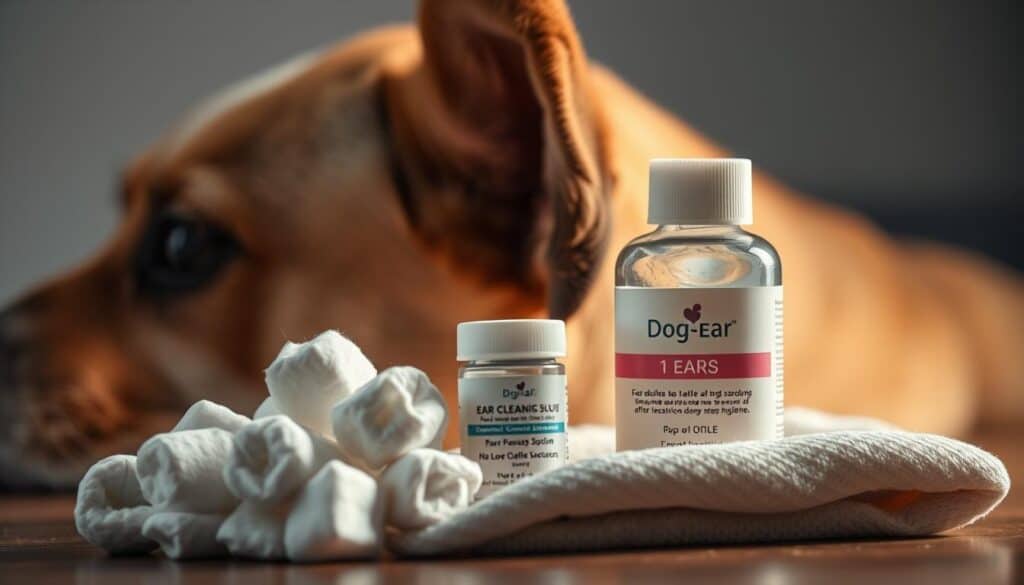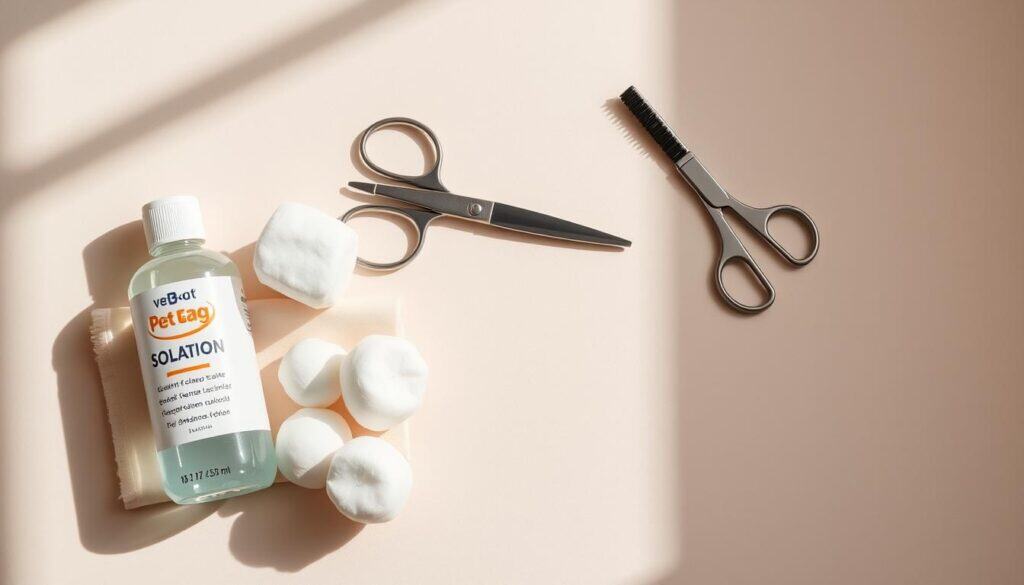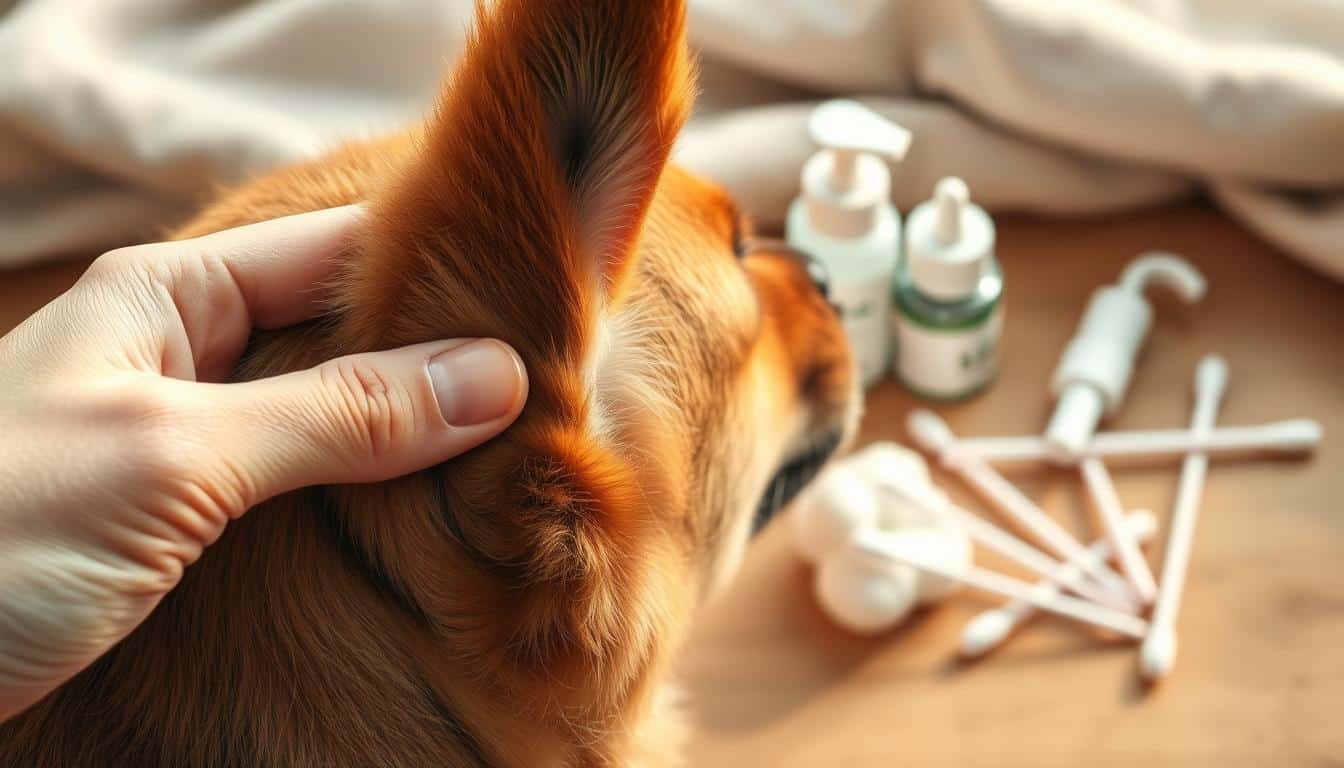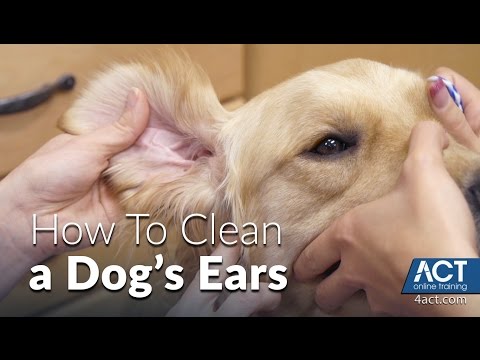Maintaining a pet’s ear health is a critical part of preventative care. Without proper attention, debris and moisture can accumulate in the unique L-shaped structure of their ear canals. This buildup often leads to discomfort, infections, or even long-term issues. Regular at-home care helps minimize these risks while saving time and money compared to frequent vet visits.
Many owners underestimate how simple it is to integrate ear maintenance into their routine. Using veterinarian-approved solutions and gentle techniques, even first-timers can manage this task effectively. The process not only prevents bacterial growth but also creates opportunities to spot early signs of irritation or inflammation.
This guide focuses on practical, stress-free methods tailored for pets. It emphasizes safety, proper tools, and recognizing when professional help is needed. By following these steps, owners gain confidence in supporting their companion’s well-being proactively.
Key Takeaways
- Regular maintenance prevents infections caused by trapped debris.
- At-home care reduces grooming costs and vet expenses.
- Proper technique ensures comfort and safety during cleaning.
- Monitoring ear health helps catch issues early.
- Always consult a veterinarian for persistent odors or redness.
Introduction to At-Home Dog Ear Cleaning
Routine maintenance plays a crucial role in preventing common health challenges for furry companions. Their unique ear structure—featuring a vertical ear canal—traps moisture and debris, creating ideal conditions for microbial growth. Breeds with folded ears, such as Cocker Spaniels, face higher risks due to limited airflow.
Why Regular Ear Cleaning Matters
Accumulated wax and dirt create breeding grounds for bacteria and yeast. Without intervention, minor irritations can escalate into painful ear infections. Floppy-eared breeds often require biweekly attention, while upright-eared varieties like German Shepherds need monthly checks. Early detection of redness or odor helps avoid complications like hearing loss.
The Benefits of a DIY Approach
Learning proper techniques empowers owners to address issues before they worsen. Consistent at-home care reduces grooming expenses and minimizes vet trips for routine cleanings. It also strengthens the bond between pets and their families through gentle, stress-free interactions.
Simple tools like vet-approved solutions and cotton pads make maintenance manageable. Observing the ear canal during sessions allows owners to spot abnormalities quickly, ensuring timely professional intervention when needed.
Understanding the Importance of Dog Ear Hygiene
Healthy ears contribute to a pet’s comfort and vitality. When neglected, moisture and debris create ideal conditions for harmful microorganisms. Left unchecked, these issues escalate quickly, affecting both physical health and behavior.

Risks of Ignoring Maintenance
Unaddressed ear problems often lead to persistent pain and inflammation. Pets may scratch excessively, causing open wounds or skin damage. Chronic infections can spread deeper into the ear canal, increasing treatment complexity.
| Symptom | Potential Outcome | Action Needed |
|---|---|---|
| Foul odor | Bacterial or yeast overgrowth | Veterinary assessment |
| Dark discharge | Advanced infection | Prescription medication |
| Head tilting | Middle ear involvement | Immediate care |
How Infections Affect Wellness
Untreated ear infections strain the immune system and may trigger secondary issues. Inflammation can spread to facial nerves or balance organs, leading to coordination problems. In severe cases, permanent hearing loss disrupts communication and safety awareness.
Regular checks help catch redness or swelling early. This proactive approach minimizes discomfort and prevents costly interventions later. Always consult a professional if unusual symptoms persist beyond 48 hours.
Essential Tools and Preparations for a Safe Clean
Proper preparation transforms routine care into a smooth, stress-free experience. Having the right supplies on hand ensures efficiency while prioritizing safety during the process.

Gathering Cleaning Materials
Start with a vet-approved ear cleaner designed to break down wax without harsh chemicals. Avoid alcohol-based solutions, which can cause irritation. Soft cotton balls or gauze pads work best for wiping away debris—never use cotton swabs, as they risk pushing dirt deeper.
- pH-balanced liquid solution
- Absorbent towels for spills
- High-value treats for rewards
Setting Up a Calm Cleaning Space
Choose a quiet room with minimal distractions. Lay down a non-slip mat or towel to help pets feel secure. Dim lighting and soothing background noise can ease anxiety. Keep sessions short, and make sure to reward cooperation with praise or snacks.
Position supplies within easy reach to maintain focus. If working with a wiggly companion, gently wrap them in a blanket to limit sudden movements. Consistency in location helps build familiarity over time.
Mastering dog ear cleaning diy: Essential Steps and Techniques
Effective maintenance requires attention to detail and patience. By following a structured approach, owners can ensure thorough care while minimizing stress for their companions.
Inspecting the Ear for Issues
Begin by examining the ear canal under good lighting. Look for redness, swelling, or unusual discharge. A healthy inner ear appears pale pink with minimal wax. If a pungent odor or dark debris is present, consult a veterinarian before proceeding.
Applying the Cleaning Solution and Massaging
Hold the solution bottle near—not inside—the canal. Squeeze gently to release liquid without creating pressure. Massage the base for 20-30 seconds to loosen buildup. “This technique helps distribute the solution evenly,” explains one veterinary technician.
Proper Debris Removal and Drying
Allow natural head shaking to expel loosened particles. Use cotton balls gauze to gently wipe from deeper folds outward. Always use fresh materials for each side to prevent cross-contamination. Finish by patting dry with a soft towel.
Reward cooperation with treats to build positive associations. Consistency in technique ensures long-term ear health and reduces risks of complications.
Practical Dos and Don’ts for Effective Ear Cleaning
Balancing safety with effectiveness requires understanding best practices and common errors in ear maintenance. Proper techniques prevent irritation while maintaining hygiene, especially for active pets prone to debris buildup.
Safe Practices to Follow
Veterinarians recommend pH-balanced ear cleaners or diluted apple cider vinegar for gentle wax removal. Cooled green tea serves as a soothing alternative for sensitive pets. Always inspect for redness or discharge before starting.
Use cotton balls to wipe visible areas, never probing deeply. Clean every 2-4 weeks, adjusting for swimming habits or ear shape. After application, massage the base ear gently and dry thoroughly with a soft cloth.
Common Pitfalls to Avoid
Hydrogen peroxide and rubbing alcohol strip natural oils, causing dryness and irritation. Avoid these harsh agents—they’re unsuitable for delicate skin. Never clean visibly infected ears without professional guidance.
Q-tips risk pushing debris deeper or damaging the eardrum. “Improper tools turn routine care into hazards,” warns a groomer with 15 years’ experience. Lastly, skipping the drying step invites moisture-related infections.
Conclusion
Proactive care transforms routine maintenance into a cornerstone of pet wellness. Regular checks and gentle cleaning routines prevent common issues like infections caused by trapped debris or excess wax. Simple homemade solutions—such as diluted apple cider vinegar or cooled green tea—offer affordable alternatives to commercial cleaners while maintaining skin health.
For hesitant companions, gradual introduction builds trust. Pair sessions with treats and calm reassurance to create positive associations. Focus on visible areas using soft cotton balls, avoiding deep probing in the canal to prevent irritation.
Consistency in care allows early detection of redness, odor, or unusual discharge. While DIY methods effectively manage minor concerns, persistent symptoms like head shaking or visible pain require professional evaluation. Veterinarians provide tailored guidance for chronic conditions or complex cases.
By integrating these practices, owners safeguard their pet’s comfort and reduce long-term health risks. A balanced approach—combining at-home diligence with expert support—ensures lasting wellness and strengthens the bond between pets and their families.




